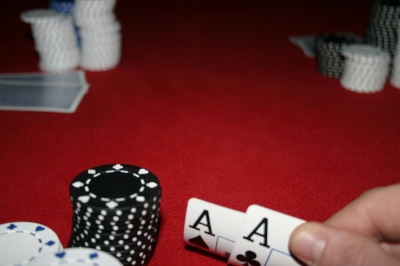|
 "How
could something so bad, darling, "How
could something so bad, darling,
come from something that was so good"
-- Bruce Springsteen
The starting hand fetish that many weaker players fixate on as a central aspect of their games directly leads to a corresponding lack
of ability to lose well. Players look at AK or QQ in Texas Holdem and think "wow, what a great hand" and start counting the
money they will be raking in. The game is not that easy however.
Take the confrontation of AsKc versus QhJh suited. This is about a 60/40 confrontation when both hands go to the showdown. A three to
two advantage should be solidly profitable of course, but it should not surprise anyone when the 40% wins a hand. But it is not even
this simple. News flash, there is betting in poker. How these hands are played can very significantly alter how much money changes
hands. It's even very likely that an excellent player in
position with the QJ will have a better
expectation than a weak player holding the AK. The weaker player
might chase or pay off far too liberally while the excellent player might be able to get away from their hands before the bigger betting rounds.
Manipulation of the betting is a key concept in itself, but the focus here is on the specific situation of something that looks "so
good" ending up being played "so bad".
One of the common errors in Hold'em, much more so than other games, is to cling to hands that look good long after they turn bad. (And then of course, tell
bad beat stories about how these "great hands" lost.)
One of the clearest signs of a player who will never rise above the mediocre is the inability to laydown pocket pairs after the flop
-- and more specifically, hands like QQ on an AT9 flop. You see it all the time, players calling off all their chips with only a
prayer and the worst straightforward draw in poker -- trying to spike an underpair two-outer. In Limit Hold'em this is sin enough, but
in No Limit it borders on lunacy. Still, spend fifteen minutes observing the one or two table mini-tournaments available online at the
various cardrooms and you likely will see this exact phenomenon happen at least once.
And the funny thing is, many of these same people will be able to lay down KJ on an AJ8 flop but will call all their money with QQ.
When facing a bet, the difference in current value between these two hands in miniscule, but the somehow the prettier QQ gets players
to act like dopes. It's just "so good" looking. Frankly, I prefer the prettiness of how good chips look in front of me in
contrast to how they look being pushed to my opponent.
You don't get "pretty points" bonuses in poker. What you get is an opportunity to manipulate the mathematical expectation of situations.
Better players often beat weaker players for a lot of chips even though the better player is holding worse cards than the weaker player. In a way,
this is the idea of most of the game. Sure, better players playing better cards will beat weaker players when they play (too often) their weaker cards,
but a more critical divide between the better players and the weaker ones is the ability to transform what should be negative situations into positive ones.
The combination of factors at work are the better player's skills, and the weaker player's
anti-skills.
Another way to put it is: giving a weak player a good starting hand is like giving him a rope to hang himself with.
Just because something starts out nicely doesn't mean it will end that way. Starting hands are merely that, a start. Clinging to good starting hands (that miss the flop) for too long, is an enormous hole in most people's play -- and it critically
afflicts the type of person whom it hurts the worst, players who rely on the most straightforward starting hands, particularly pocket pairs.
There is nothing wrong with pretty hands. Just don't be seduced to the point pretty turns into "pretty ugly."
More articles focusing on Starting Hands |

